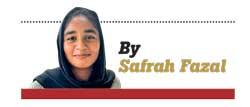Reply To:
Name - Reply Comment
|
|
|
|
|
How has this culture of posters, cutouts, and handbills gradually fizzled out? Candidates and political parties believe and trust electronic and print media unlike before Most of them are trying to use Google ads and Facebook Meta ads Given the Regulation of Election Expenditure Act (No. 3 of 2023), most candidates would avoid putting up posters, cutouts, or hoardings in the run-up to this election The strategy of smaller political parties is mostly the distribution of leaflets in areas like the Fort Railway Station and bus stops There is great importance in providing election manifestos in a concise format to educate voters on the parties’ policies |
 It cannot be denied that the poster culture of the yesteryears is largely bygone. The people of this nation no longer have to shield their eyes from the reds, blues, greens and maroons wedged in every nook and cranny of the streets, or yank bundles of cards and leaflets stuffed through gates and mailboxes to dump them in the nearest bin. So, how has this culture of posters, cutouts, and handbills gradually fizzled out? Would this also be a cause for concern in terms of voter education?
It cannot be denied that the poster culture of the yesteryears is largely bygone. The people of this nation no longer have to shield their eyes from the reds, blues, greens and maroons wedged in every nook and cranny of the streets, or yank bundles of cards and leaflets stuffed through gates and mailboxes to dump them in the nearest bin. So, how has this culture of posters, cutouts, and handbills gradually fizzled out? Would this also be a cause for concern in terms of voter education?
Dearth of posters and poster pasters
During late-night commutes, witnessing mostly youth balancing buckets of wheat paste in one hand and paint rollers being run up and down posters, especially during election time, was somewhat common years ago. Where have these youth gone?
According to Manjula Gajanayake, Executive Director of the Institute for Democratic Reforms and Electoral Studies, there is a dearth of people to put up posters. “That generation is gone. Now there is no labour force for such matters. Last time, most youth received job opportunities in the Government sector for merely helping put up posters. Also, the Election Commission is taking action against those who put up posters, and election monitoring bodies are complaining about it too,” he said.
  “During previous elections, posters and cutouts drastically decreased as election monitoring bodies continuously carried out campaigns about how such materials were harmful to the environment”- “During previous elections, posters and cutouts drastically decreased as election monitoring bodies continuously carried out campaigns about how such materials were harmful to the environment”- Rohana Hettiarachchi, Executive Director of People’s Action for Free and Fair Elections |
Speaking of the fewer election promotional materials seen today, Gajanayake added that most candidates and political parties are now moving to the digital sphere from the poster culture of bygone years. “One reason that we don’t see many posters and cutouts this time compared to previous elections is that it is a transition time, and most of the candidates and political parties are trying to shift their promotional strategies from poster format to online or digital formats. Most candidates and political parties believe and trust electronic and print media unlike before. The other factor is Meta. Most of them are trying to use Google ads and Facebook Meta ads. Hence, not many posters and cutouts are seen,” he observed.
Gajanayake added that the drastic decline in printed promotional materials is positive and welcomed in terms of the environment. On the other hand, with the Regulation of Election Expenditure Act (No. 3 of 2023), most candidates would avoid putting up posters, cutouts, or hoardings in the run-up to this election.
|
|
Rohana Hettiarachchi, Executive Director of People’s Action for Free and Fair Elections (PAFFREL), observed that during this election, there has been more suspense as to whom some of the major political parties would field as their candidate; which could partly be the reason for fewer posters and other printed promotional materials.
Hettiarachchi added, “During previous elections, posters and cutouts drastically decreased as election monitoring bodies continuously carried out campaigns about how such materials were harmful to the environment”.
Voter education
When posters and other such promotional materials are taken down, will there be an impact on voter education, especially among rural communities who have little or no access to digital promotional materials?
“My suggestion is to get the Election Commission or District Election Offices to distribute election manifestos or promotional materials printed in black and white to each household. Putting a halt to promotional material is one thing, but equal distribution of election-related material is another. We must promote voter education,” Gajanayake noted.
However, while the major political parties can afford to distribute a summary of their manifesto to households, this would not be possible for other candidates and smaller parties contesting the elections.
“The strategy of smaller political parties is mostly the distribution of leaflets in areas like the Fort Railway Station and bus stops. According to the Presidential Election Act, there are restrictions in doing so. This is an environmental issue no doubt when leaflets are thrown everywhere; but, the reality is that it is an innocent and simple promotional strategy meant to educate the voters about their policies and other such details. We don’t need to impose the law in such a way,” Gajanayake noted.
“In most Scandinavian countries, 60% of the campaign funds for candidates are provided by the Government. These countries can afford to do that since they are strong economies, but Sri Lanka isn’t. Therefore, the Election Commission can request the Government printer to produce simple material in black and white introducing the profile of the party and candidate along with their picture and other necessary details,” Gajanayake added.
He further said that since there are 14,022 Grama Niladhari Divisions around the country, some space can be made to put up flyers of the contestants—candidate’s picture, symbol, and other details. “This can be managed by District Election Offices too,” Gajanayake emphasised.
Hettiarachchi highlighted the importance of providing election manifestos in a concise format to educate voters on the parties’ policies. He added that PAFFREL was carrying out discussions with political parties to discuss the outline required of manifestos. “A manifesto should detail why voters should cast their votes to a particular candidate as opposed to the others. Nobody is going to read an entire manifesto; a summary of the manifesto would serve the purpose,” said Hettiarachchi.
What Does the Law Say?
For how long would we see the posters and cutouts that are put up now?
According to Section 74 of the Presidential Elections Act (No. 15 of 1981), Provisions relating to the display of handbills, posters, etc., during the period commencing from the day of nomination (which is August 15) and ending on the day following the day on which a poll is taken at such an election, no person shall, for the purpose of promoting the election, display in any premises, whether public or private, any flag or banner except in or on any vehicle that is used for the conveyance of a candidate at such election; or any handbill, placard, poster, notice, photograph of a candidate, symbol, sign or drawing on any place to which the public have a right of, or are granted, access except in or on any premises on any day on which an election meeting is due to be held in such premises; or any handbill, placard, poster, notice, photograph of a candidate, symbol, sign, drawing, flag or banner, on or across any public road; or any handbill, placard, poster, notice, photograph of a candidate, symbol, sign, or drawing in or any vehicle, except in or on any vehicle that is used for the conveyance of a candidate at such election.
Section 74 further states that any person guilty of the offense shall, on conviction after summary trial before a Magistrate, be liable to a fine not exceeding one hundred rupees or to imprisonment of either description for a term not exceeding one month or to both such fine and imprisonment. It also empowers Police officers to seize and remove any handbill, placard, poster, notice, photograph of a candidate, symbol, sign, drawing, flag, or banner used in such contravention.
According to Channa De Silva, the Media Coordinator of the Election Commission, the posters and cutouts put up in Colombo will be taken down by Police officers in the coming days.